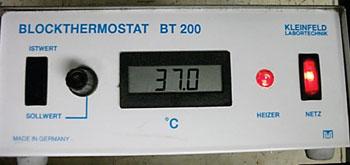LAMP Method Detects Malarial Parasites Using Microwave Irradiation
By LabMedica International staff writers
Posted on 11 Dec 2014
A rapid and reliable nucleic acid extraction procedure from human blood and malarial parasites using microwave irradiation as a promising platform has been described.Posted on 11 Dec 2014
Although microscopy of blood smears is still considered the gold standard for diagnosing malaria infections, microscopy is frequently unable to detect low-density infections and requires skilled expertise.

Image: The Blockthermostat BT 200 (Photo courtesy of Kleinfeld Labortechnik).
Scientists at the University of Tübingen (Germany) working with colleague in the Republic of Congo collected venous blood samples either into 5 mL heparinized tubes or by finger prick with blood stored on sterile Whatman filter paper at admission to the Albert Schweitzer Hospital (Lambaréné, Gabon) from patients suffering from severe Plasmodium falciparum infections.
DNA was extracted from whole blood samples as well as from the cultured parasites of the dilution series using the conventional QIAamp DNA mini blood kit based extraction procedure (Qiagen; Hilden, Germany). A tailored loop mediated isothermal amplification (LAMP) methodology was used that utilized hydroxynaphthol blue (HNB) and Bacillus stearothermophilus (Bst 2.0) DNA polymerases for the molecular detection of malarial parasites. The LAMP assay reactions were performed using two heat blocks (Block Thermostat BT 200, Kleinfeld Labortechnik, Gehrden, Germany) and preheated to 60 °C for DNA amplification for 45 minutes, and enzyme inactivation for two minutes at 80 °C.
Following microwave irradiation for DNA isolation, conventional polymerase chain reaction (PCR) assays were able to detect up to five malaria parasites/µL. The LAMP methodology was capable to detect as low as one P. falciparum parasite/µL after DNA extraction by microwave irradiation. A turnover time of 45 minutes from nucleic acid extraction to final visual read-out was achieved. The amplicon was visualized through a distinct color change and subsequently confirmed by gel electrophoresis. A change from violet to light sky blue was considered a positive result of amplification. If the reaction remained violet, the sample was assessed as being negative.
The authors concluded that the LAMP procedure offers a cheap, simple and fast method of molecular detection of malaria parasites. This test can easily be performed in basic laboratories. The methodology has been validated as a proof of concept and has specifically been developed for use at low-resource settings. Such rapid molecular diagnostic tests may aid health providers to make timely therapeutic interventions in malaria endemic regions. The study was published on November 24, 2014, in the Malaria Journal.
Related Links:
University of Tübingen
Albert Schweitzer Hospital
Kleinfeld Labortechnik













